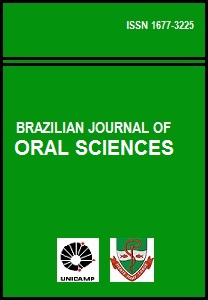Abstract
Aim: The aim of this study was to investigate mean electrical activity and how the anterior, middle, and posterior portions of the temporalis muscle work during mastication. Methods: The sample consisted of 16 healthy male college freshmen trichotomized, aged between 18 and 25 years, with Angle’s Class I and no temporomandibular disorders. Electromyographic (EMG) recordings were made in anterior, middle and posterior portions of the temporalis muscle during mastication for 5 s. Results: It was found a significantly lower RMS value in the posterior portion (RMS: 1243.92) compared with those of the anterior (RMS: 2149.77) and middle (RMS: 2531.38) portions. Conclusions: There is an association between the portions of the temporalis muscle. It was found a significantly lower RMS value in the posterior portion showing that the anterior and middle portions of the muscle have a predominant function of maintaining movement during mastication.The Brazilian Journal of Oral Sciences uses the Creative Commons license (CC), thus preserving the integrity of the articles in an open access environment.
Downloads
Download data is not yet available.

